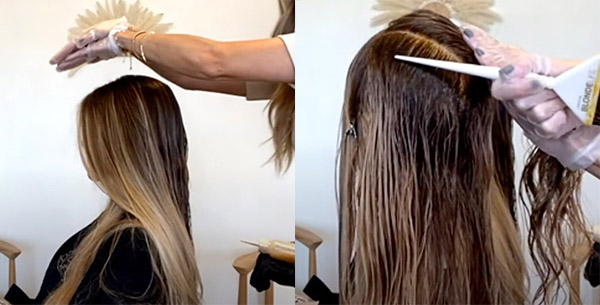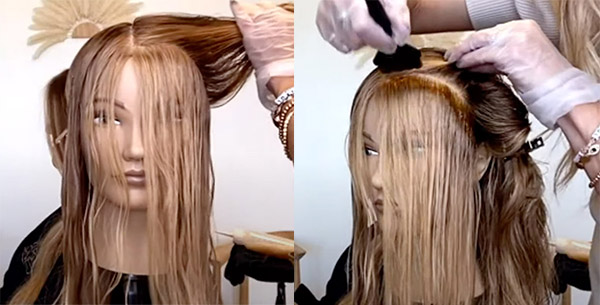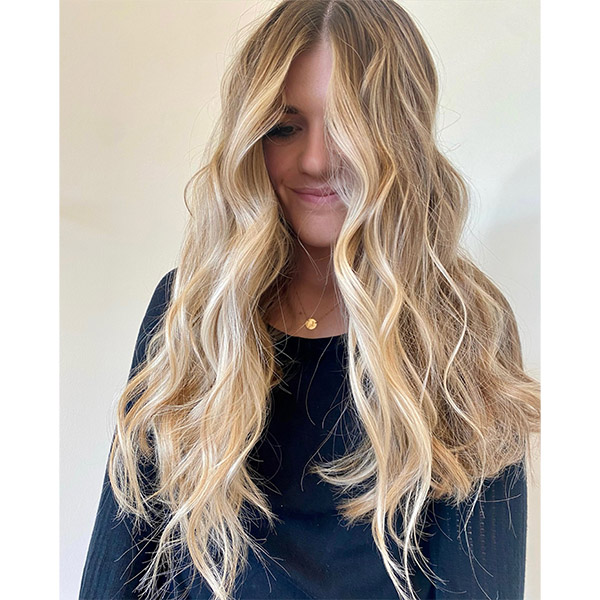Root Taps, Shadows & Melts—Do You Know The Difference?
3 Ways To Elevate Toning For Lived-In Blondes
When creating a lived-in look, which technique delivers the most natural result: root tap, back tap, shadow root or root melt? Trick question—all of the above! Joico Celebrity Artist Jill Buck (@jill901) is here to explain what each of these techniques are, plus when and where to use them when blending out harsh lines.
Technique #1: Root Melt For Interior Depth
Jills wants her end result to be bright around the face and have more depth in the interior. So, she applies her root melt in the back sections first, so it has a longer processing time.
Thinking of the hair in zones: Zone 1: The base, Zone 2: The mids and Zone 3: The ends—Jill focuses her root melt in Zone 1. To achieve a flawless melted effect, Jill applies her product in a V-shape.
Below, she demonstrates with the back of her brush how far down she tones the root melt.

Try Jill’s go-to products to achieve a naturally bright, healthy blonde: Joico Blonde Life Demi-Gloss Toners, Lightening Powder and Coconut Oil Developers.
Technique #2: Natural Shadow Root Roadmap
Jill’s fool-proof trick for mapping out a shadow root? She places her hands above the client’s head and notes where there is a natural shadow. Not only does this create a natural placement, but it helps the client visualize what their shadow root will look like before Jill applies product.

When applying her root shadow, Jill works in a teardrop section, only applying her formula to the base and stopping right at the round of the head, helping her achieve a natural, lived-in result.
Technique #3: Back Tap For A Bright Face Frame
Here’s the thing: Blondes want to SEE brightness. That’s why Jill opts for a back tap along the hairline. Sectioning off the hairline to stay organized, Jill grabs a smaller brush (for more control) and taps the toner just enough to blur any lines of demarcation.
Pro Tip: If you’re doing this technique at the bowl, don’t direct the hair away from the face. Jill likes to bring the hair towards the face so that she can hit the top side of the hair.

But Wait—What Is The Difference Between A Root Tap & Back Tap?
Root Tap:
- Tapping toner onto the roots, about an inch or two down
- Painting both sides of the hair
- Jill uses this technique for clients with thick/coarse hair and brunettes/darker tones
Back Tap:
- Tapping toner onto the roots, about an inch or two down
- Painting only one side of the hair, letting the toner penetrate through to both sides
- Jill uses this technique for clients with finer hair and blondes/lighter tones
Slide to see the before & after:

Tap the beaker to see Jill’s formula:


Get a FREE sample of Blonde Life: click here!
This content is sponsored.
More from
Joico
-
Balayage
One Step, Three-Layer Multidimensional Balayage
-
Balayage
Sunset Copper Balayage
-
Monthly Product Launch List
The Best Hair Launches Of March 2024
-
Hair Color
Blonde Life® SilverLight™ Lightening Powder
-
Bond Building
Defy Damage® IN A FLASH™
-
Da’Vine Joy Randolph’s Glamour Waves
-
Celebrity
Zendaya’s Classic Volume Bob
-
Celebrity
The Best Beauty Looks At The 2024 Oscars
-
Blonde
Building The Perfect “Summer Blonde”
-
Gray
Make Gray Hair Look & Feel Younger: 3 Tips Every Stylist Should Try
-
Haircare
KBOND20 Defy Damage Power Masque
-
BTC Events
BTC “On Tour” Nashville Recap: Everything You Missed
-
Monthly Product Launch List
The Best Hair & Beauty Launches Of November 2023
-
Haircare
Inner Joi™ Strengthen Shampoo
-
Conditioners
Inner Joi™ Strengthen Conditioner
-
Haircare
Inner Joi™ Strengthen Masque
-
Haircare
Joico Launches Vegan, Naturally-Derived Haircare Line, Inner Joi™
-
Blonde
How To Create A Natural Shadow Root Through Teasing
-
Blonde
“Fake” A Full Foil In 3 Steps: Here’s How
-
BTC Hair Trend Report
Your Guide To Fall & Winter 2023’s Hair Color Trends
-
Blonde
Honey Blonde Curls: 3 Strategic Placement Tips To Create Brightness
-
Hair Color
Bold Color Trends You Need To Know For 2024
-
BTC Events
AI, Mental Health & Social Media: 7 Business Tips You Can’t Live Without
-
Manufacturer
Joico Announces Jeannetta Walker-Rodgers as Global Technical Director






